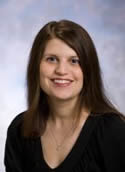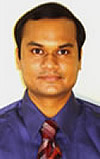|
A new addition to our Web site this year in 2010 is a page we call, Where Are They Now?
This page includes brief biographies of former graduate students, postdoctoral fellows, and residents who were members of our muscle group during their training years. Included are their research accomplishments and honors, as well as their current positions, which we plan to update on a regular basis. We hope this page will serve to both give our visitors a glimpse into the types of students and postdoc fellows that trained with us, as well as provide us a way to stay in touch with these researchers.
2009-2010
Louise Rodino-Klapac, Ph.D.
 Dr. Rodino-Klapac performed her postdoctoral studies in the Mendell lab from 2006-2010. Her research focused on developing gene therapy based vectors for the treatment of neuromuscular disorders, with emphasis on translating laboratory benchside research to the bedside. Her research laid the foundation for vascular delivery gene therapy trials in a critical study in mdx mice, the model for Duchenne muscular dystrophy, and developing gene therapy based therapeutics for other forms of muscular dystrophy. Honors for Louise include a Ruth L. Kirschstein Post-doctoral Fellowship, an Excellence in Translational Medicine Award, and multiple presentation awards from The Research Institute at Nationwide Children’s Hospital. Louise published 12 articles during her postdoctoral studies in journals such as Mol. Therapy, Sci. Transl. Med., and New England J. Med. She is currently an Assistant Professor of Pediatrics at the Research Institute at Nationwide Children’s Hospital. Dr. Rodino-Klapac performed her postdoctoral studies in the Mendell lab from 2006-2010. Her research focused on developing gene therapy based vectors for the treatment of neuromuscular disorders, with emphasis on translating laboratory benchside research to the bedside. Her research laid the foundation for vascular delivery gene therapy trials in a critical study in mdx mice, the model for Duchenne muscular dystrophy, and developing gene therapy based therapeutics for other forms of muscular dystrophy. Honors for Louise include a Ruth L. Kirschstein Post-doctoral Fellowship, an Excellence in Translational Medicine Award, and multiple presentation awards from The Research Institute at Nationwide Children’s Hospital. Louise published 12 articles during her postdoctoral studies in journals such as Mol. Therapy, Sci. Transl. Med., and New England J. Med. She is currently an Assistant Professor of Pediatrics at the Research Institute at Nationwide Children’s Hospital.
Chalonda R. Handy, Ph.D.
Dr. Handy’s thesis studies were conducted in the Kaspar lab at the Research Institute at Nationwide Children’s Hospital. She entered the Integrated Biomedical Science Program at The Ohio State University in 2004 and graduated in 2009. Her graduate research involved the use of gene therapy techniques to investigate potential therapeutics for neuromuscular disorders including Duchenne Muscular Dystrophy, Merosin deficiencies and Amyotrophic Lateral Sclerosis (ALS). Chalonda published 4 articles during predoctoral studies in journals including Sci. Transl. Med., and PNAS. She left Columbus in February 2010 and is currently a postdoctoral fellow at Emory University in the Boulis lab with a continuing interest in researching neurodegenerative disorders using cell and gene based therapies.
Jason Dahlman, Ph.D.
 Dr. Dahlman performed his graduate studies in the Guttridge lab at The Ohio State University. He was in the Integrated Biomedical Science Program from 2003-2009. His research focused on the role of the NF-kB signaling pathway in skeletal muscle differentiation, with an emphasis on early postnatal muscle development. His research identified the role of NF-kB as a regulator of iNOS in the stromal cellular compartment of maturating postnatal muscle. Jashon’s honors include a presentation award from the College of Medicine at The Ohio State University. He published 6 articles while in graduate school in such journals as Cancer Cell, J. Cell Biol., J. Biol. Chem. and J. Cell. Biochem. Jay is currently performing postdoctoral studies in the Yang lab at the NIH in Bethesda. He continues to pursue his interest in cell signaling, but has switched to studying the Wnt pathway in mesenchymal stem cells. Dr. Dahlman performed his graduate studies in the Guttridge lab at The Ohio State University. He was in the Integrated Biomedical Science Program from 2003-2009. His research focused on the role of the NF-kB signaling pathway in skeletal muscle differentiation, with an emphasis on early postnatal muscle development. His research identified the role of NF-kB as a regulator of iNOS in the stromal cellular compartment of maturating postnatal muscle. Jashon’s honors include a presentation award from the College of Medicine at The Ohio State University. He published 6 articles while in graduate school in such journals as Cancer Cell, J. Cell Biol., J. Biol. Chem. and J. Cell. Biochem. Jay is currently performing postdoctoral studies in the Yang lab at the NIH in Bethesda. He continues to pursue his interest in cell signaling, but has switched to studying the Wnt pathway in mesenchymal stem cells.
Amanda Haidet, Ph.D.
 Dr. Haidet’s graduate studies were conducted in the Kaspar lab at the Research Institute at Nationwide Children’s Hospital. She entered the Integrated Biomedical Science Program at The Ohio State University in 2005 and recently graduated in 2010. Her dissertation research focused on understanding how glial cells impact motor neuron survival in the context of Amyotrophic Lateral Sclerosis (ALS). Specifically, she developed a novel stem-cell based in vitro model of ALS where motor neurons can be co-cultured with astrocytes isolated from the ALS mouse model. In addition, she worked on a collaborative project with Mendell lab investigating the effects of AAV-delivered follistatin on muscle mass and strength in a mouse model of Muscular Dystrophy. Amanda’s honors include a Predoctoral University Fellowship from The Ohio State University. She was a predoctoral fellow on the IBGP T32 training grant and then obtained her own F31 Ruth Kirschstein National Research Service Predoctoral Fellowship Award. Amanda published 8 articles while in graduate school that appeared in such journals as Sci. Transl. Med., Nature Biotechnology, and PNAS. She is currently a postdoctoral fellow at Johns Hopkins University in the Department of Neurology in the Maragakis lab, continuing her interests in the role of astrocytes in ALS. Dr. Haidet’s graduate studies were conducted in the Kaspar lab at the Research Institute at Nationwide Children’s Hospital. She entered the Integrated Biomedical Science Program at The Ohio State University in 2005 and recently graduated in 2010. Her dissertation research focused on understanding how glial cells impact motor neuron survival in the context of Amyotrophic Lateral Sclerosis (ALS). Specifically, she developed a novel stem-cell based in vitro model of ALS where motor neurons can be co-cultured with astrocytes isolated from the ALS mouse model. In addition, she worked on a collaborative project with Mendell lab investigating the effects of AAV-delivered follistatin on muscle mass and strength in a mouse model of Muscular Dystrophy. Amanda’s honors include a Predoctoral University Fellowship from The Ohio State University. She was a predoctoral fellow on the IBGP T32 training grant and then obtained her own F31 Ruth Kirschstein National Research Service Predoctoral Fellowship Award. Amanda published 8 articles while in graduate school that appeared in such journals as Sci. Transl. Med., Nature Biotechnology, and PNAS. She is currently a postdoctoral fellow at Johns Hopkins University in the Department of Neurology in the Maragakis lab, continuing her interests in the role of astrocytes in ALS.
Michelle Asp, Ph.D.
 Dr. Asp conducted her dissertation research in the Belury Lab in the Department of Human Nutrition at OSU. She entered the OSU Interdisciplinary Nutrition PhD Program in 2006 and graduated in the summer of 2010. Her research focused on understanding the role of insulin resistance and metabolic dysregulation in cancer cachexia. She found that insulin resistance occurs early in the pathogenesis of cachexia and is associated with markers of altered substrate utilization in skeletal muscle. Michelle authored in four peer-reviewed publications in journals including Inter. J. of Cancer, and Am. J. Clin. Nutrition. For honors, she received the Myrtle Wolcott Cram Graduate Research Fellowship from the College of Education and Human Ecology as well as the OSU Presidential Fellowship, with additional awards from the American Society for Nutrition and the P.E.O. Scholar Awards Program. Michelle is now doing post-doctoral research in the Metzger Lab at the University of Minnesota, where her research is centered on understanding the mechanisms of heart function and disease and translating these discoveries to the development of potential therapies for heart failure. Dr. Asp conducted her dissertation research in the Belury Lab in the Department of Human Nutrition at OSU. She entered the OSU Interdisciplinary Nutrition PhD Program in 2006 and graduated in the summer of 2010. Her research focused on understanding the role of insulin resistance and metabolic dysregulation in cancer cachexia. She found that insulin resistance occurs early in the pathogenesis of cachexia and is associated with markers of altered substrate utilization in skeletal muscle. Michelle authored in four peer-reviewed publications in journals including Inter. J. of Cancer, and Am. J. Clin. Nutrition. For honors, she received the Myrtle Wolcott Cram Graduate Research Fellowship from the College of Education and Human Ecology as well as the OSU Presidential Fellowship, with additional awards from the American Society for Nutrition and the P.E.O. Scholar Awards Program. Michelle is now doing post-doctoral research in the Metzger Lab at the University of Minnesota, where her research is centered on understanding the mechanisms of heart function and disease and translating these discoveries to the development of potential therapies for heart failure.
Ravi Singh, Ph.D.
Dr. Singh graduated from the Chandler Lab at Nationwide Children’s Hospital. Ravi was part of the Molecular and Cellular Developmental Biology Graduate Program. His research focused on understanding post-transcriptional processes, such as alternative splicing in development and disease. During his graduate studies he developed an in vitro splicing model system using MDM2 minigenes to identify damage-induced regulators (cis elements and trans factors) of alternative splicing of the oncogene MDM2 and its relevance in Rhabdomyosarcoma. He was an author in 4 publications in such journals as, Exp Cell Res., Cancer Cell, and Cancer R. Ravi is currently performing postdoctoral research in the Cooper Lab at Baylor College of Medicine, where he is studying muscle specific splicing pathway/factors that are utilized during development and often misregulated in muscle disorders.
Michelle M. Monasky, Ph.D.
Dr. Monasky conducted her graduate studies in the Janssen lab at The Ohio State University. She graduated in 2010 from the Biophysics Graduate Program. Her research included investigating the mechanism of myocardial relaxation using changes in muscle length. Her findings include a dissociation between the time for the intracellular calcium transient decline and the time for force decline, which conclude that the rate of myocardial relaxation is predominately determined by the myofilaments, and not the time for calcium decline, under the conditions studied. During her dissertation years Michelle published 8 articles and was awarded an American Heart Association Predoctoral Fellowship. Her honors included the Outstanding Student Research Achievement Award in the Biophysics Graduate Program, First Place Margaret T. Nishikawara Scholar Award for Outstanding Student from the Department of Physiology and Cell Biology, various presentation and travel awards from OSU and outside of OSU, invited presentations outside of OSU, and a mention in both the Biophysical Society and American Physiological Society newsletters. Michelle is currently a Postdoctoral Fellow at the University of Illinois at Chicago in the lab of R. J. Solaro, where she is continuing to investigate the role of the myofilaments in disease.
Baijayanta Maiti, M.D., Ph.D.
 Dr. Maiti performed his graduate studies in the Flanigan lab from 2004-2009. His research focused on the molecular pathogenesis of select point mutations in the DMD and SEPN1 gene, which helped elucidate key aspects of protein translation and function. His studies provided crucial insights into the underlying mechanism of internal initiation of translation within the DMD coding sequence, and novel mechanism by which point mutations in SEPN1 gene affects translation of selenoprotein N. He published 4 articles while in graduate school in such journals as Hum Mutat, J Clin Invest, Brain and was also received presentation awards in meetings like the International Congress of World Muscle Society and the New directions in Biology and Disease of Skeletal Muscle conference. Dr. Maiti is currently in neurology residency program at Washington University in St. Louis and intends to pursue translational research in the near future. Dr. Maiti performed his graduate studies in the Flanigan lab from 2004-2009. His research focused on the molecular pathogenesis of select point mutations in the DMD and SEPN1 gene, which helped elucidate key aspects of protein translation and function. His studies provided crucial insights into the underlying mechanism of internal initiation of translation within the DMD coding sequence, and novel mechanism by which point mutations in SEPN1 gene affects translation of selenoprotein N. He published 4 articles while in graduate school in such journals as Hum Mutat, J Clin Invest, Brain and was also received presentation awards in meetings like the International Congress of World Muscle Society and the New directions in Biology and Disease of Skeletal Muscle conference. Dr. Maiti is currently in neurology residency program at Washington University in St. Louis and intends to pursue translational research in the near future.
Jordan Gladman, Ph.D.
 Dr. Gladman is a recent graduate of the Integrated Biomedical Science Program at The Ohio State University. Jordan performed his thesis research in the Chandler lab where he researched the pediatric disease Spinal Muscular Atrophy. Jordan generated a new mouse model of Type III/IV spinal muscular atrophy (SMA) and identified novel sequence elements that help determine the mRNA splicing of the Survival Motor Neuron (SMN) gene. Jordan has published three papers during his graduate studies that include, Front. In Biosci, Human Genetics, and Human Molecular Genetics. Jordan is currently performing post-doctoral research studying the molecular genetics and biology of myotonic dystrophy in the Mahadevan lab at the University of Virginia. Dr. Gladman is a recent graduate of the Integrated Biomedical Science Program at The Ohio State University. Jordan performed his thesis research in the Chandler lab where he researched the pediatric disease Spinal Muscular Atrophy. Jordan generated a new mouse model of Type III/IV spinal muscular atrophy (SMA) and identified novel sequence elements that help determine the mRNA splicing of the Survival Motor Neuron (SMN) gene. Jordan has published three papers during his graduate studies that include, Front. In Biosci, Human Genetics, and Human Molecular Genetics. Jordan is currently performing post-doctoral research studying the molecular genetics and biology of myotonic dystrophy in the Mahadevan lab at the University of Virginia. |
|

